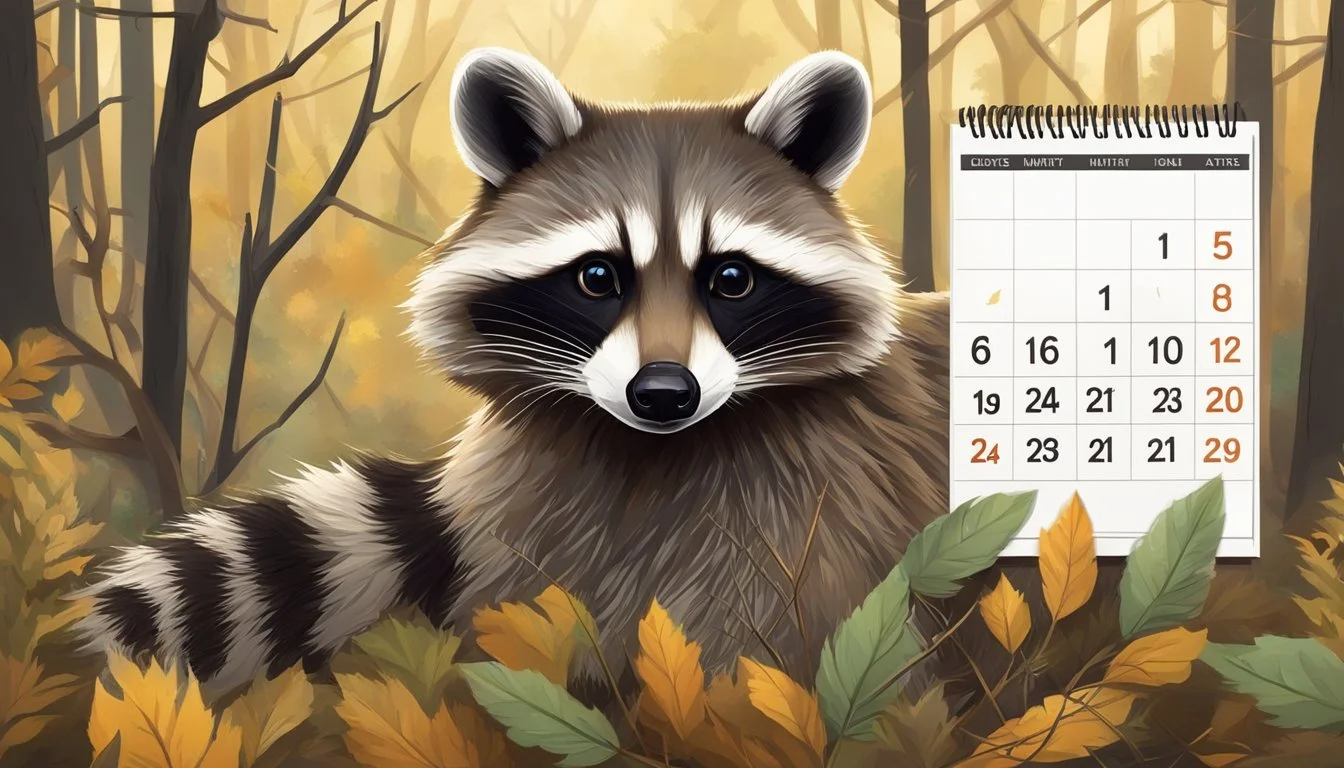Raccoon Hunting Seasons
Regulations, Timing, and Conservation Practices
This Article is Part of Our Guide on Hunting Seasons for Over 70 Common Game Species
Raccoon hunting is a practice with a longstanding tradition in many parts of the United States. It serves as both a form of wildlife management and a cultural pastime. Each state regulates its own hunting seasons, during which hunters can legally pursue raccoons. The regulations are set by wildlife agencies to ensure the balance of the ecosystem is maintained and to provide hunters with guidance on when it is permissible to hunt these animals.
Hunters looking to participate in raccoon hunting should familiarize themselves with their state's specific dates, as these vary considerably. For instance, in Missouri, raccoon hunting is allowed from November 15, 2023, to February 29, 2024, where artificial lights can be used if raccoons are treed with the aid of dogs. Tennessee also offers opportunities for raccoon hunting, citing a season that typically aligns with the best practice of wildlife management.
Methods for hunting and trapping can include the use of dogs, foot-enclosing traps, and cage-type traps, depending on the time of year and specific regulations. It is important for hunters to adhere to the stipulated dates and methods to ensure compliance with the law and to support sustainable hunting practices. These regulations are essential not only for the conservation of raccoon populations but also to ensure that the hunting traditions can continue responsibly for future generations.
Understanding Raccoons
Raccoons are adaptable, nocturnal animals known for their dexterity and diverse diet. Understanding their biology and the environments they thrive in is crucial for any discussion about hunting seasons.
Biology and Habits
Raccoons (Procyon lotor) are medium-sized mammals with a distinctive black mask across their eyes and a bushy, ringed tail. They possess highly sensitive front paws and an acute sense of touch, which, along with their intelligence, makes them adept at navigating their environments and finding food. As omnivores, raccoons have a varied diet that can include fruits, nuts (how long do nuts last?), insects, and small animals.
They are primarily nocturnal, meaning most of their foraging and activity takes place at night. In urban areas, raccoons are often seen rifling through garbage cans in search of a meal, highlighting their ability to adapt to various food sources and environments.
Raccoon Habitats
Raccoons are found across a broad range of habitats, from rural to urban areas. They prefer forested areas near water sources but have shown remarkable adaptability by thriving in urban settings where they can often be found in proximity to humans.
In cities, raccoons may den in hollow trees, abandoned buildings, or even storm sewers. Their flexibility in diet and habitat makes them a common sight in many neighborhoods, leading to their classification in some regions as a nuisance species, particularly when they encroach upon human dwellings.
Legal Framework
The legalities of raccoon hunting are governed by strict regulations including the requirement of valid hunting licenses and permits, adherence to specific hunting regulations, and compliance with bag limits and quotas. These regulations are typically enforced by the state's Department of Natural Resources or equivalent agency.
Hunting Licenses and Permits
Individuals seeking to hunt raccoons must hold the proper licenses and permits. These are typically issued by the state's wildlife authority and may vary by state. For instance, the Missouri Department of Conservation requires a valid permit for raccoon hunting. Some states may offer extended trapping seasons on private land, which could necessitate additional or separate permitting.
Hunting Regulations
Hunting regulations stipulate the legal methods and seasons for raccoon hunting. In some regions, artificial lights can be used when hunting with the aid of dogs if raccoons are treed. However, during certain dates, only specific types of traps such as foot-enclosing traps and cage-type traps are permitted. Regulations may vary between public land and private property, with some states providing more relaxed rules for private landowners.
Bag Limits and Quotas
Each state has established bag limits and quotas to manage wildlife populations. These limits ensure that raccoon hunting does not adversely affect the species' long-term viability. Hunters must adhere to these quotas, which can change annually based on wildlife population studies and conservation needs. Agencies such as the Department of Natural Resources monitor and enforce these limits to promote sustainable hunting practices.
Raccoon Hunting Seasons
Raccoon hunting seasons vary by state, often spanning from fall to late winter, with some regional variations extending the trapping season or providing specific details regarding permissible hunting methods.
Seasonal Timing
Missouri:
Regular season: November 15 through February 29
Extended trapping on private land: March 1 to April 14
General Pattern:
Typically, raccoon hunting seasons in most states start in October and last until the end of February.
Regional Variations
Missouri:
Use of artificial lights is permitted when raccoons are treed with the aid of dogs.
From August 1 to October 15, only foot-enclosing traps and cage-type traps may be used.
Alabama:
There is no closed season for hunting raccoons.
On privately owned and leased lands, there is no bag limit.
On open-permit public lands, the limit is 5 per party.
There are restrictions on running dogs during certain times in the spring turkey season.
Tennessee:
Raccoon season runs from November 10 through January 31.
It's essential for hunters to check with their local wildlife agency for specific dates, as these can vary depending on the area.
Hunting Methods and Equipment
Successful raccoon hunting relies on the proficient use of a range of methods and equipment. Each method requires specific tools and knowledge to ensure effective and ethical hunting practices.
Using Firearms
Firearms provide a traditional and effective method for raccoon hunting. Hunters typically use shotguns due to their short-range effectiveness, or modern firearms for longer distances. Safety is paramount, so hunters must adhere to all regulations regarding firearm use. The following firearms are commonly used:
Shotguns with small pellets are preferred for their spread pattern that increases the likelihood of a clean shot.
Modern firearms like rifles may be used where regulations permit, facilitating longer-range shots with precision.
Trapping Techniques
Trapping is a widely used method for capturing raccoons, especially outside the regular hunting season. Trappers must follow specific state regulations regarding trap types and trapping periods. Two principal trap types include:
Foot-enclosing traps: Permissible in some areas during specific dates; designed to hold the raccoon without causing excess harm.
Cage-type traps: Humane and non-lethal, allowing for the safe release of non-target species.
Hunting With Dogs
Hunting with dogs is a time-honored tradition in raccoon hunting. Canines provide assistance by tracking the scent and treeing raccoons. Essential points to consider:
Headlamps or artificial light may be used to aid hunters and their dogs during nighttime hunts, as it is allowed in some regions when raccoons are treed.
Dogs should be well-trained to follow raccoon scents and to tree the game, maximizing the efficiency of the hunt.
Preparation and Safety
In raccoon hunting, preparation is as critical as the hunt itself. Equipping oneself with the right gear and adhering to safety guidelines ensures a responsible and enjoyable hunting experience.
Equipment Checklist
A hunter must ensure that their equipment list is comprehensive and specific to raccoon hunting. Here is an essential checklist:
Firearms and Ammunition: Verify the firearm is suitable for small game and loaded with the appropriate ammunition.
Lights: Since raccoon hunting often occurs at night, a high-quality, durable light is vital.
Artificial Lights: Some states allow the use of artificial lights for raccoon hunting; check local regulations.
Protective Gear: Include gloves and eye protection.
Safety Guidelines
Safety cannot be overstated in hunting practices. It's imperative to follow these guidelines:
Firearm Handling: Always treat firearms as if they are loaded and ensure the muzzle is pointed in a safe direction.
Artificial Light Use: Be aware of state regulations regarding the use of lights; some states may have specific restrictions on air space illumination.
Communication: Always inform someone about your hunting location and expected return time.
First Aid: Carry a basic first aid kit and be familiar with its contents.
By taking these precautions and following the checklist, hunters can focus on the activity with peace of mind, knowing they are prepared and acting safely.
Processing and Utilization
After a successful raccoon hunt, processing the animal and utilizing every part is both respectful and practical. Hunters have the responsibility to handle the game in a way that maximizes the use of the raccoon's resources.
Skinning and Cleaning
The first step in processing is skinning the raccoon, which should be done carefully to preserve the quality of the fur. The skinning process involves making precise cuts around the raccoon's body to remove the pelt without damaging it. Once the skin is removed, cleaning the carcass is essential to prepare it for further use or consumption. This process must comply with all local regulations regarding game processing.
Uses for Raccoon Pelts
Raccoon pelts have historically been used to create a variety of items, including warm fur coats. The quality of the pelt affects its value and potential applications:
Prime pelts: Used in high-quality fur coat production.
Lesser quality pelts: Often used for trim, accessories, or other crafts.
Properly processed and treated, raccoon fur can provide durable and warm clothing options, contributing to sustainable use practices.
Conservation and Ethics
Raccoon hunting seasons are carefully regulated to align with conservation goals and ethical standards. These regulations ensure the sustainability of raccoon populations while addressing their impact on the environment.
Environmental Impact
Raccoon Overpopulation: Raccoons can significantly impact local ecosystems, particularly when their populations become too large. They are known to predate on bird eggs and nestlings, which can affect native bird populations. By maintaining controlled hunting seasons, like the one in Tennessee from mid-September to February, states manage these environmental impacts.
Habitat Preservation: Ethical hunting practices also involve the preservation of raccoon habitats. Hunters must respect the ecosystems in which racoons live, ensuring that their actions do not lead to habitat destruction or fragmentation.
Ethical Considerations
Humane Hunting Practices: States mandate specific hunting methods and equipment to ensure humane treatment of raccoons. For example, Missouri allows the use of artificial lights when raccoons are treed with the aid of dogs, simplifying the hunt and reducing the potential for prolonged pursuit.
Seasonal Restrictions: Adherence to designated seasons, such as Iowa's fur-harvesting season from November 4 to April 15, reflects an ethical approach to hunting. These restrictions avoid breeding seasons and times of year when raccoons are particularly vulnerable, like extreme winter conditions where they might struggle to find food and shelter.
By following these regulations and considering the environmental impact and ethical considerations, hunters contribute to the responsible management of raccoon populations and their habitats.
Related Species and Their Seasons
Hunting seasons for various species are established to manage wildlife populations and ensure sustainable harvests. These seasons can vary widely by state and are often scheduled to coincide with periods of least vulnerability for the animals, such as outside their breeding season.
Coyote and Fox
Coyote hunting is often less restricted, as they are considered a nuisance in many regions due to their adaptability and impact on livestock. In some areas, coyote hunting is permitted year-round, while in others, it might have specific seasons which can overlap with deer or elk season.
Coyote Season: Year-round or coinciding with other big game seasons.
Elk Season: Usually falls in the autumn months; specific dates vary by state.
Fox hunting seasons can be more regulated, tending to align with other small game species. Seasons typically occur during the fall and winter months, with variation across different states.
Red Fox Season: Often October to February.
Gray Fox Season: Generally similar to red fox; check local regulations.
Opossum and Bobcat
Opossum hunting seasons typically occur during the cooler parts of the year to reduce stress on the animal and avoid the hot summer months. These seasons can run concurrently with other fur-bearing species.
Opossum Season: Usually from October to February; can vary by state.
Bobcat seasons are more tightly regulated due to conservation efforts. Hunters may be required to obtain special permits, and there may be a bag limit to prevent overharvesting.
Bobcat Season: Dates and regulations are state-specific; often require special permits.
It's critical for hunters to verify the exact dates and regulations with their local wildlife agencies before planning their hunting activities.
Challenges and Solutions
In raccoon hunting, enthusiasts face specific obstacles while ensuring populations are controlled effectively. This section breaks down the key hurdles and the strategic responses necessary for a successful and responsible hunting experience.
Common Challenges in Raccoon Hunting
Raccoon hunting presents a unique set of challenges due to the behaviors and natural defenses of these mammals. Here are some common issues hunters face:
Elusiveness: Raccoons are nocturnal and have a keen sense of awareness, making them difficult to locate and target.
Seasonal Variation: Hunting seasons vary by state, requiring hunters to stay informed about legal hunting periods to avoid penalties.
Nuisance Potential: In urban areas, raccoons can become a nuisance, complicating their management as both pests and game animals.
Effective Strategies
To manage the challenges, hunters and wildlife agencies employ particular strategies:
Education and Training: Hunters must educate themselves on raccoon behavior and learn tracking skills to improve their success rates.
Regulation Compliance: Adhering strictly to state regulations, including season dates and bag limits, ensures the legal and ethical hunting of raccoons.
Preventive Measures: In urban settings, reducing food sources and properly securing trash can diminish raccoon-human conflicts without the need for hunting.
Advancements and Innovation
In the field of raccoon hunting, ongoing advancements in technology have brought new dimensions to this traditional activity.
Electronic Calls and Equipment
The advent of electronic calls represents a significant innovation in raccoon hunting. These devices can replicate the sounds of prey or other raccoons, which, when played, can attract raccoons to a specific area. They often provide a variety of sounds, allowing hunters to adapt to different hunting situations and times of the year.
Electronic calls come with a range of functionalities:
Programmability: Hunters can load custom sounds specific to their hunting area.
Remote Operation: Allows for sound activation from a distance, minimizing human presence.
Durability: Constructed to withstand outdoor conditions.
When selecting electronic calls, hunters should consider:
Sound Quality: Clear and realistic sounds are more likely to lure raccoons.
Battery Life: Longer battery life ensures the electronic call can last through the hunting session.
Range: A remote with a greater range increases the hunter’s flexibility in positioning.
Alongside electronic calls, other innovative equipment enhancements include improved night vision optics for nocturnal hunts and the integration of GPS technology for tracking hunting dogs and the path of pursued raccoons. These tools have refined the hunting experience, making it more effective and efficient.
State-Specific Information
Raccoon hunting regulations vary by state, and it's essential for hunters to be aware of the specific rules that apply to the areas where they plan to hunt. Below are the details for Michigan and Tennessee.
Michigan Raccoon Hunting
In Michigan, raccoon hunting seasons are specified by the Michigan Department of Natural Resources (DNR). The hunting season typically runs from:
October 1 to January 31 for firearm and crossbow hunting
February 1 to March 31 for hunting with dogs only (no firearms)
The hunters must possess a base license to hunt raccoons. The bag limit and other restrictions may change yearly, so hunters should consult the DNR for the most current regulations.
Tennessee Raccoon Hunting
Tennessee raccoon hunting seasons are outlined by the Tennessee Wildlife Resources Agency. Hunters in Tennessee can hunt raccoons during the following times:
Sunset on the fourth Friday in September to sunrise on the last day of February
Tennessee requires hunters to have a valid hunting license. The state also imposes a bag limit, which is subject to change, so checking with the state agency for current limits is advisable.
Both states encourage hunters to practice ethical hunting methods and to be mindful of their responsibilities in wildlife conservation.
Conclusion
Raccoon hunting, often referred to as coon hunting, is a regulated activity in many states, principally occurring from October to February. Those interested should verify exact dates and regulations through their local wildlife agency. It's a practice rooted in tradition, requiring skill in tracking and trapping these nocturnal mammals.
Proper preparation is essential for a safe and successful hunt. Hunters must equip themselves with the necessary gear and knowledge of raccoon behavior. Moreover, understanding the ecological role of raccoons can enhance the hunting experience.
It is crucial to note that beyond sport, raccoon hunting can also be a measure to manage wildlife interactions, particularly where raccoons pose threats to crops or property. In such circumstances, trapping may be permissible year-round, subject to state regulations.
Prospective hunters must adhere to ethical hunting practices, ensuring they contribute to conservation efforts by following the established guidelines. By doing so, they partake in a time-honored tradition while helping to balance the raccoon populations within their natural habitats.
Additional Resources
The following subsections provide targeted information for those seeking deeper insights into raccoon hunting. Readers will find a selection of curated resources to expand their understanding and connect with experienced communities.
Further Reading
Official State Regulations: State Department of Conservation or Natural Resources websites are indispensable for up-to-date hunting seasons, bag limits, and regulations.
Wildlife Journals: Scholarly articles and studies in wildlife journals offer comprehensive insights into raccoon behaviors and patterns that could be beneficial for hunting.
Organizations and Communities
Local Hunting Clubs: Many states have hunting clubs that welcome new members and provide a wealth of shared knowledge on hunting raccoons.
Online Forums: Platforms like HuntingNet or Reddit’s hunting communities are good places for discussions, advice, and sharing experiences with fellow enthusiasts.











